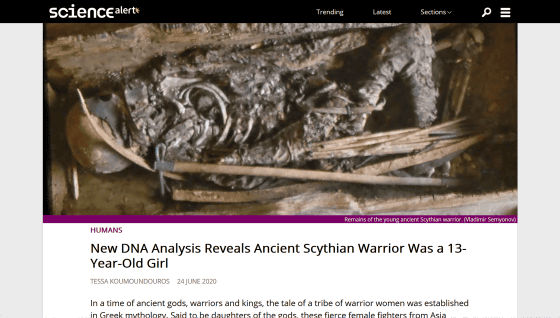DNA test revealed that the body of an ancient nomadic warrior who had been considered to be a man was a 'girl under 13'

by
In Greek mythology, a tribe called Amazone, which consisted only of women, appeared and was reportedly a hunting tribe that tamed horses and fought. Although it is said that Amazon exaggerated the tribal tribes that lived on the Black Sea coast, the Scythians of the nomadic horse races that appeared in the record from around the 9th century BC were actually girls of age 13 years old. DNA tests revealed that there was a 'female warrior'.
The Unique Burial of a Child of Early Scythian Time at the Cemetery of Saryg-Bulun (Tuva)
https://www.e-anthropology.com/English/Catalog/Archaeology/STM_DWL_QeAy_gDibiVkQf93i.aspx
Scythian Warrior's Genome Analyzed-Archeology Magazine
https://www.archaeology.org/news/8802-200617-scythian-mummy-genome
New DNA Analysis Reveals Ancient Scythian Warrior Was a 13-Year-Old Girl
https://www.sciencealert.com/new-dna-analysis-reveals-an-ancient-scythian-warrior-was-a-13-year-old-girl

For many years the legend of 'female warriors' was considered to be a mere imaginary product, but in recent years archaeological evidence of the existence of female warriors has been discovered. By the end of 2019, it was revealed that the two Scythian warriors found in western Russia, buried about 2500 years ago, are women.
The two female warriors were buried together with the other women, and the burial items included an iron knife, over 30 arrowheads, and a harness for horse riding. It is said that one of them was wearing a headdress with a flower-shaped decoration at the age of 40 to 50 years old, and the other was buried at the age of about 30 to 35 years old, straddling a horse.
'We can say that these two were indeed horsemen,' said Valerii Guliaev, an archaeologist at the Institute of Archeology of the Russian Academy of Sciences . Guliaev's research team seems to have discovered 11 women who were buried under the armed condition in the past 10 years, and female warriors were undergoing the same burial ceremony as male warriors. thing.

by Institute of Archeology, Russian Academy of Sciences
In the wake of Guliaev's findings, another research team focused on the Scythian warriors found in the Tuva Republic in 1988. Varvara Busova, an archaeologist at the Russian Academy of Sciences, discovered that the warrior was a young man because he had found burial items such as axes and bows that would normally be housed with men, and no burial items associated with women such as beads and mirrors. It was thought to have been.
The warrior was housed in a larch casket with various weapons and was partially mummified. When the research team examined the DNA of the body, it was found that the body was female and that the age was not even 14 years old. Girl warrior is wearing, such as fur coats, coat dipodidae seems to have been made by Awa connect the skin.
Radiocarbon dating of burial items suggests that the girl was buried between the 7th and 5th centuries BC, but Busova's research team wants to more accurately identify when the girl was buried. thinking about. In addition, it may be possible to find out the cause of the girl's death by performing restoration work of the burial goods and CT scan of the body.
Historian Adrian Mayer pointed out that the Scythians had female warriors because they were small as a social group. 'Since they lived in a small tribe, it makes sense that everyone in the tribe is a stakeholder. They all had to contribute to defense, war, and hunting.' Says Mayer.

by Vladimir Semyonov
Related Posts:
in Note, Posted by log1h_ik







